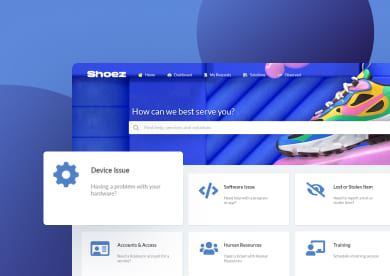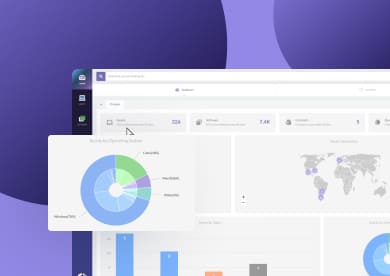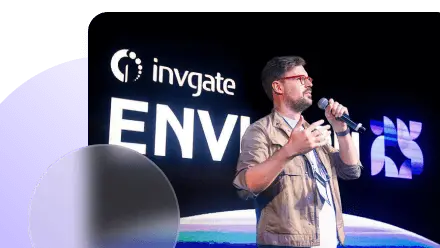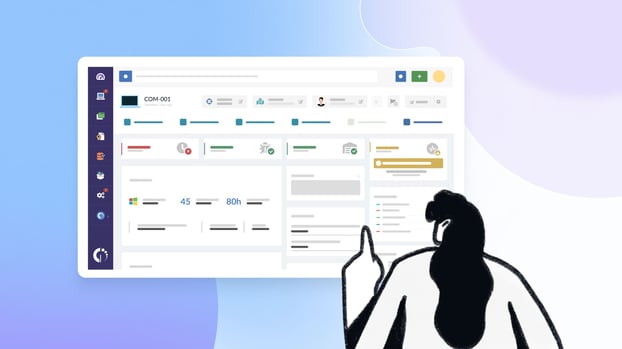Cloud Asset Management software is a smart move for modern IT teams. It helps you manage your assets from anywhere, scale with your needs, and avoid the hassle of on-premise maintenance.
But here’s the catch: picking the right tool isn’t easy. There are a lot of options out there. And every organization has its own goals, budget, and way of working. What works for one team might not work for another.
That’s why we put together this list — to help you compare top tools and find the one that fits your needs. Let’s get started.
What is Cloud Asset Management software?
Cloud Asset Management software helps you track, organize, and control your cloud-based resources — like SaaS subscriptions, virtual machines, and cloud infrastructure.
These tools are usually cloud-based themselves, so you can access them from anywhere. They give you visibility over usage, costs, security risks, and compliance issues related to cloud services.
Some are focused only on managing cloud-native environments. Others are part of broader IT Asset Management platforms, combining cloud, software, hardware, and even non-IT assets in one place.
Either way, they’re essential to stay in control of your tech stack in a world where everything is moving to the cloud.
Best Cloud Asset Management software
There’s no one-size-fits-all solution when it comes to managing cloud assets. That’s why we created a list that mixes full IT Asset Management platforms with specialized tools for SaaS tracking, cloud cost optimization, and hybrid infrastructure management.
Here are 10 standout options to consider:
- InvGate Asset Management – A full ITAM platform that combines cloud, software, hardware, and even non-IT assets in one centralized, cloud-based solution.
- ManageEngine AssetExplorer – A reliable ITAM tool with strong discovery and lifecycle tracking for hybrid environments.
- ServiceNow IT Asset Management – Enterprise-grade Asset Management with advanced automation and integrated cloud spend control.
- Apptio Cloudability – A cloud-native platform focused on multi-cloud cost optimization, budgeting, and FinOps automation for AWS, Azure, and GCP.
- Snow Atlas – A cloud-native platform focused on SaaS and Software Asset Management with deep licensing insights.
- Certero for Cloud – Designed for full visibility across SaaS, IaaS, and PaaS, with strong compliance and cost tracking features.
- Nutanix – A hybrid cloud infrastructure platform that helps manage and optimize multi-cloud and on-prem resources from a single control plane.
- Densify – AI-powered cloud resource management tool that helps rightsize and plan infrastructure across AWS, Azure, and GCP.
- Flexera One – A powerful FinOps and ITAM platform built for enterprises needing deep visibility into cloud cost, usage, and governance.
| Tool name | Best feature | Hosting | Free trial | Pricing |
| InvGate Asset Management | Full ITAM software for every IT asset | Cloud and on-premise | 30 days | Starts at $0.21/node/month |
| ManageEngine AssetExplorer | Hybrid asset discovery with license tracking | Cloud & on-premise | 30 days | Free (up to 25 assets); from ~$115/month |
| ServiceNow IT Asset Management | Deep ITSM + ITAM integration with automation | Cloud (SaaS) | Contact vendor | Quote-based |
| Apptio Cloudability | Multi-cloud cost visibility & rightsizing | Cloud (SaaS) | 30 days | Quote-based |
| Snow Atlas | SaaS & software license visibility | Cloud (SaaS) | Not available | Quote-based |
| CerteroX Cloud Management | Unified multi-cloud cost governance | Cloud (SaaS) | Not available | Quote-based |
| Nutanix Cloud Manager | Hybrid infrastructure automation & cost control | Cloud & on-premise | Not available | Quote-based |
| Densify | AI-powered rightsizing for cloud & K8s | Cloud (SaaS) | 30 days | $2.50–$15 per unit/month |
| Flexera One | Enterprise FinOps & ITAM in one platform | Cloud (SaaS) | Not available | Quote-based |
#1. InvGate Asset Management

InvGate Asset Management is a comprehensive IT Asset Management platform designed for ease of use. With its intuitive interface and no-code approach, it allows users to fully leverage its capabilities with minimal technical knowledge.
Additionally, InvGate Asset Management is both flexible and scalable. It can be deployed on-premise or in the cloud and grows alongside your organization, making it a perfect solution for businesses of any size.
The platform also offers a wide array of integrations — from ITSM tools to remote desktop, authentication systems, and cloud services — and leverages powerful automation and artificial intelligence (AI) through its native AI Hub.
InvGate Asset Management features
With InvGate Asset Management, you have all the features needed to manage your cloud and IT environment. These are its main cloud asset management functionalities:
- Comprehensive asset discovery & inventory – Automatically discovers and inventories all IT assets, including hardware, software, virtual, cloud, and non-IT assets, using both agent-based and agentless methods.
- SaaS and cloud service tracking – Identifies and monitors cloud-based applications across the organization, offering insights into usage and ownership.
- Software License Management – Tracks software and SaaS licenses to ensure compliance, detect unauthorized usage, and prevent vendor-related risks.
- Software metering & optimization – Monitors cloud and on-premise software usage to reduce unnecessary spending and optimize license allocation.
- Configuration Management Database (CMDB) – Maps relationships between cloud and on-prem assets to business services, helping teams understand dependencies.
- Cloud Asset Lifecycle Management – Tracks the full lifecycle of cloud resources, including usage trends, contract renewals, and cost monitoring.
- Automated workflows – Automates common tasks such as license assignment and deprovisioning with Smart Tags and AI-powered suggestions.
- AI Hub – Provides intelligent automation suggestions, smart tagging, and asset insights to streamline decision-making.
- Integrations with cloud tools and identity providers – Connects with tools like Microsoft 365, Okta, and Active Directory to enrich asset tracking and visibility.
InvGate Asset Management pros
- Intuitive and easy-to-use interface.
- Strong automation features with Smart Tags and AI-driven recommendations.
- Cloud and on-premise deployment options.
- Centralized visibility of all assets (cloud, software, hardware, non-IT).
- Seamless integrations with 20+ tools, including ITSM and authentication systems.
- Quick implementation and no-code customization.
- Excellent onboarding and responsive customer support.
InvGate Asset Management reviews and comments
InvGate Asset Management holds an average rating of 4.7 out of 5 stars on Gartner Peer Insights, with reviewers praising its usability and automation capabilities.
“Having used other helpdesk products in the past I feel that this one is in a class of its own. Easy to use and navigate. Extremely helpful support team that is willing to take the time to help after purchase support us the product.”
Gartner Peer Insights reviewer
The platform is also featured in Gartner’s Market Guide for Hardware Asset Management Tools as a representative vendor, highlighting its strong capabilities in lifecycle management and infrastructure visibility.
InvGate Asset Management pricing
InvGate Asset Management offers transparent pricing based on the number of nodes you need to manage (a "node" being any monitored device):
- Starter Plan – $0.21 per node/month, billed annually, for up to 500 nodes (minimum $1,250/year).
- Pro Plan – $0.38 per node/month, billed annually, for 501–10,000 nodes.
- Enterprise Plan – Custom pricing for large-scale or complex environments (includes on-premise deployment, SSO, and advanced configurations).
You can try the platform with a 30-day free trial, no credit card required.
#2: ManageEngine AssetExplorer
 ManageEngine AssetExplorer is a flexible IT Asset Management solution designed for organizations that need full lifecycle asset tracking. It offers both cloud and on-premise deployment options and is a great fit for small to mid-sized businesses looking for centralized visibility over their IT and cloud assets.
ManageEngine AssetExplorer is a flexible IT Asset Management solution designed for organizations that need full lifecycle asset tracking. It offers both cloud and on-premise deployment options and is a great fit for small to mid-sized businesses looking for centralized visibility over their IT and cloud assets.
Its ability to integrate with other ManageEngine tools and ITSM platforms makes it a practical choice for IT teams that want to link asset data to help desk operations.
ManageEngine AssetExplorer features
- Asset discovery across environments – Uses agent-based and agentless methods to discover hardware, software, and virtual assets, including those hosted in cloud environments.
- SaaS and License Management – Tracks software and cloud app usage to help control costs and avoid license compliance issues.
- Asset Lifecycle Management – Manages assets from procurement through retirement, including contracts, vendors, and depreciation.
- CMDB – Provides a visual view of asset relationships to better understand service impact and dependencies.
- Cloud-based access (SaaS version) – Enables remote management and centralized visibility through browser-based access.
- Reporting & alerts – Customizable reporting and automated alerts on license expiration, asset changes, or warranty end dates.
ManageEngine AssetExplorer pros
- Flexible deployment: on-premise or SaaS.
- Free edition available (up to 25 assets).
- Solid license compliance features.
- Easy to integrate within the ManageEngine ecosystem.
- Interface is user-friendly and fast to implement.
ManageEngine AssetExplorer cons
- Some advanced features require configuration and training.
- Reporting customization may require SQL knowledge.
- Limited discovery in certain cloud-specific environments compared to more cloud-native tools.
ManageEngine AssetExplorer reviews and comments
ManageEngine AssetExplorer holds an average rating of 4.3 out of 5 stars on G2.
“I liked the idea of this AssetExplorer software where one could track an asset from the time it was bought to the time when it was disposed off.”
Capterra reviewer
It’s frequently praised for its license tracking and ease of deployment, though some users mention a learning curve when customizing fields or reports.
ManageEngine AssetExplorer pricing
ManageEngine AssetExplorer is available as a cloud or on-premise solution, with a 30-day free trial to explore its features.
Pricing is tiered based on the number of assets managed. For example, the cloud version starts at around $115/month for 250 assets, with higher tiers available for larger environments.
#3: ServiceNow IT Asset Management
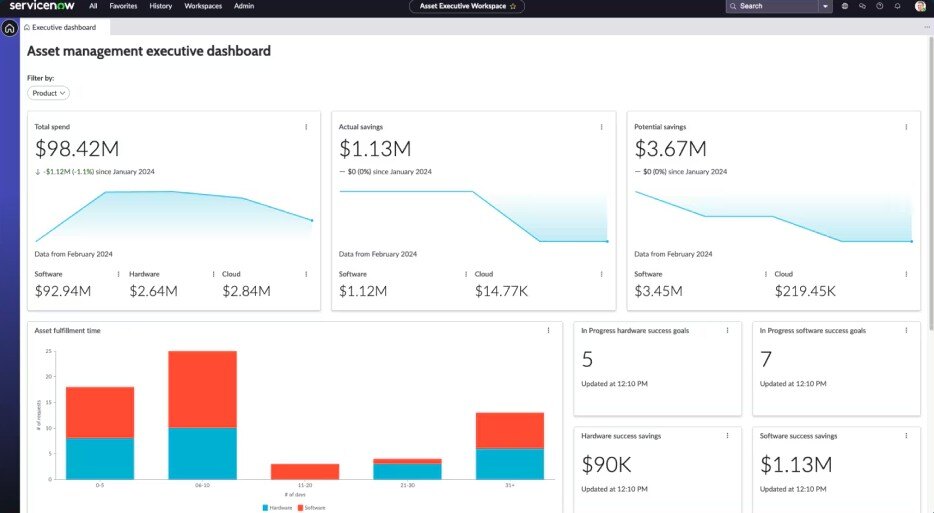 ServiceNow IT Asset Management is an enterprise-grade platform built to manage the full lifecycle of IT assets, from procurement to retirement — across both on-premises and cloud environments. It’s ideal for large enterprises with complex IT infrastructures and a need for deep process integration.
ServiceNow IT Asset Management is an enterprise-grade platform built to manage the full lifecycle of IT assets, from procurement to retirement — across both on-premises and cloud environments. It’s ideal for large enterprises with complex IT infrastructures and a need for deep process integration.
The platform is cloud-based (SaaS) and integrates natively with ServiceNow modules and third-party tools such as Azure, AWS, SCCM, Active Directory, and procurement systems — offering broad interoperability across IT and cloud ecosystems.
ServiceNow IT Asset Management features
- Cloud Resource Management – Tracks cloud infrastructure resources (e.g., AWS, Azure, GCP) and maps usage and ownership.
- SaaS license tracking – Manages subscriptions and helps optimize spend across cloud apps.
- Software Asset Management (SAM) – Handles license reconciliation, compliance, and vendor audit preparation.
- Cloud spend visibility – Monitors and reports on usage and cost to support financial planning.
- Asset lifecycle automation – Covers procurement, usage, depreciation, and retirement.
- CMDB integration – Links assets to configuration items and service dependencies.
ServiceNow IT Asset Management pros
- Deep integration with ITSM, procurement, and finance.
- Built-in workflows for cloud asset governance and optimization.
- High scalability for enterprise environments.
- Unified platform for both physical and virtual/cloud assets.
- Strong compliance and audit readiness features.
ServiceNow IT Asset Management cons
- High licensing and implementation costs.
- Can be overpriced for mid-sized organizations or limited-use cases.
- Complex configuration process and steep learning curve.
- Some features require separate modules (e.g., Cloud Insights, SAM Pro).
ServiceNow IT Asset Management reviews and comments
ServiceNow ITAM holds an average rating of 4.4 out of 5 stars on G2. Users consistently praise its integration depth and process control.
“The many Modules that can be used to incorporate our assets into the platform. Makes organizing and keeping track of our inventory almost seamless after they are scanned into the system from a management standpoint”.
G2 reviewer
It’s frequently chosen by large organizations looking to consolidate asset, license, and financial data under a single IT platform.
ServiceNow IT Asset Management pricing
ServiceNow follows a quote-based pricing model. Costs vary based on the number of users, assets, and additional modules (like SAM or Cloud Insights). Pricing is not publicly listed — organizations must contact the vendor for a tailored proposal.
#4: Apptio Cloudability
 Apptio Cloudability (an IBM/Apptio product) is a cloud Cost Management and optimization solution designed to help IT, finance, and engineering teams gain visibility into cloud spending and improve budgeting practices. Ideal for mid to large enterprises, it supports multi-cloud environments and provides advanced financial governance tools.
Apptio Cloudability (an IBM/Apptio product) is a cloud Cost Management and optimization solution designed to help IT, finance, and engineering teams gain visibility into cloud spending and improve budgeting practices. Ideal for mid to large enterprises, it supports multi-cloud environments and provides advanced financial governance tools.
Built for cloud-native use, it connects directly to providers like AWS, Azure, and GCP. Its agentless, API-first model enables fast deployment and continuous cost monitoring.
Apptio Cloudability features
-
Multi-cloud cost visibility — Aggregates billing data from AWS, Azure, and GCP into unified dashboards.
-
Budgeting & forecasting — Uses intelligent forecasting to plan cloud spend and track budget adherence.
-
Rightsizing recommendations — Delivers ML-backed suggestions for compute, storage, and container optimization across clouds.
-
Kubernetes cost insights — Tracks container-level costs and usage in AWS, Azure, and GCP Kubernetes clusters.
-
Chargeback/showback — Enables detailed cost allocation by department, application, or business unit.
-
Anomaly detection & alerts — Flags unexpected usage spikes or overspending in real time.
-
Integrations with finance & FinOps tools — Connects with business tools and tags, and provides API support for integrations.
Apptio Cloudability pros
- Strong multi-cloud visibility and advocacy for FinOps best practices.
- High-quality rightsizing and forecasting recommendations driven by ML.
- Customizable dashboards that support team-specific views and stakeholder reporting.
- Recognized as a G2 Leader for cloud Cost Management in Spring 2025.
Apptio Cloudability cons
- Can be expensive, especially for smaller organizations with modest cloud spend.
- Some users find reporting and BI tools limited or challenging to use .
- Scaling cost with spend may make it less cost-effective for low-volume users.
Apptio Cloudability reviews and comments
Cloudability averages 4.3 out of 5 stars on Gartner.
“My overall experience with Apptio has been fairly average. While it serves its purpose adequately, I find it lacks the intuitive interface and robust features I would expect from such a tool. There is a room for improvement in usability and functionality to enhance the user experience.”
Gartner Peer Insights reviewer
Apptio Cloudability pricing
Apptio Cloudability does not publish pricing on its website. Pricing is custom, based on cloud spend volume, desired modules, and feature level. A 30-day free trial is available via AWS Marketplace and directly from the vendor.
#5: Snow Atlas
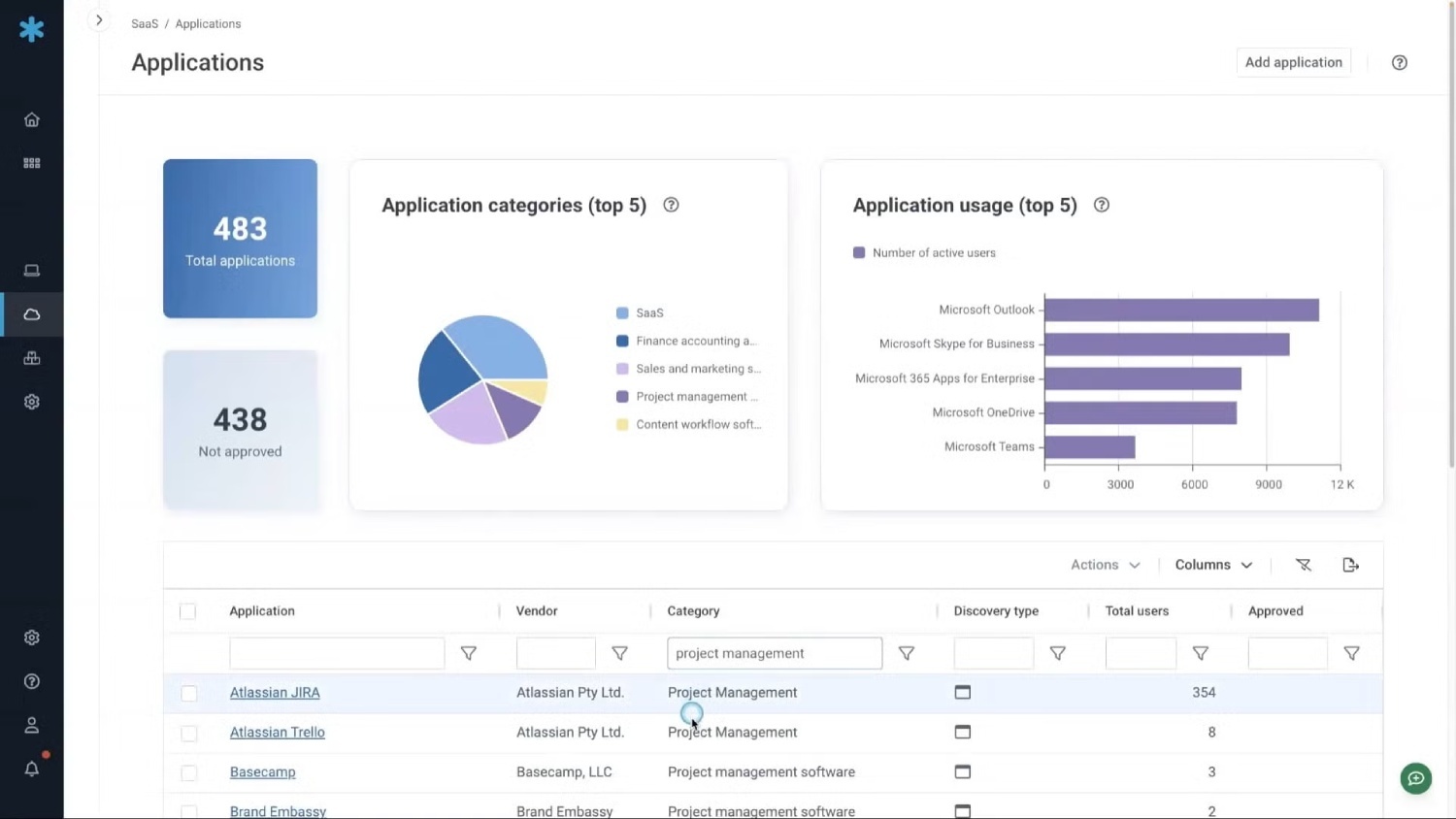 Snow Atlas is a cloud-native Software Asset Management (SAM) platform designed to help organizations gain full visibility into their software, SaaS, and cloud usage. Developed by Snow Software (now part of Flexera), it offers centralized management of software licenses, cloud subscriptions, and IT spending, all in a SaaS environment.
Snow Atlas is a cloud-native Software Asset Management (SAM) platform designed to help organizations gain full visibility into their software, SaaS, and cloud usage. Developed by Snow Software (now part of Flexera), it offers centralized management of software licenses, cloud subscriptions, and IT spending, all in a SaaS environment.
Unlike traditional ITAM tools, Snow Atlas is focused specifically on software and SaaS assets, making it a powerful choice for organizations that need deep insight into license compliance, usage, and cost control.
Snow Atlas features
- SaaS discovery and optimization – Automatically detects cloud apps in use (including shadow IT) and provides insights into licensing, usage, and renewal cycles.
- Cloud resource visibility – Tracks cloud services (IaaS, PaaS, SaaS) across providers like AWS, Azure, and GCP.
- License Compliance Management – Monitors software installations and usage to ensure adherence to vendor terms and audit readiness.
- Spend analysis and forecasting – Breaks down software and cloud spend by department, user, or region to support budgeting decisions.
- Normalized inventory data – Aggregates and cleans data from various sources for consistent reporting across hybrid environments.
- Integrations with key systems – Connects with Microsoft 365, Azure AD, AWS, SCCM, ServiceNow, and more to enrich asset intelligence.
Snow Atlas pros
- Deep SAM and SaaS Management capabilities.
- Effective at uncovering shadow IT and unused cloud apps.
- Easy to deploy and scale (cloud-native SaaS model).
- Clean, centralized dashboards for compliance and spend control.
- Continuous data normalization ensures consistent reporting.
Snow Atlas cons
- Not designed to manage hardware or non-software assets.
- May require configuration to map business units or departments effectively.
- Some users note that the learning curve is steeper for advanced reporting.
Snow Atlas pricing
Snow Atlas uses a custom pricing model based on the number of users, applications, and services being tracked. Pricing is not publicly available, and organizations must contact Snow (Flexera) for a quote. A free trial or demo may be available upon request.
#6: Certero for Cloud

CerteroX Cloud Management (part of CerteroX by Certero) is a dedicated multi-cloud cost and asset optimization platform. It offers centralized visibility and governance across AWS, Azure, and GCP, designed for mid to large enterprises and managed service providers (MSPs).
This cloud-native SaaS solution integrates with cloud provider APIs, identity platforms, and ITAM systems — bringing together cost, usage, budget control, and governance into one unified interface.
CerteroX features
-
Multi-cloud cost visibility & allocation – Tracks spend across AWS, Azure, and GCP; supports budgeting, forecasting, and cost chargeback.
-
Anomaly detection & governance – Flags cost spikes and policy violations before they escalate.
-
Workload and rate optimization – Offers automation for RI purchases, spot instance usage, and autoscaling.
-
Resource tagging & ownership – Maps assets to financial units and ensures cost accountability.
-
Cloud scheduling & quotas – Enables instance power scheduling and resource quotas to control costs.
-
Integrations – Connects seamlessly with AWS/Azure/GCP APIs and identity systems; integrates into Certero’s broader ITAM/SAM platforms.
CerteroX pros
- Unified cloud cost and asset governance in multi-cloud environments.
- Strong automation for rightsizing, quotas, and anomaly detection.
- Collaborates well with MSPs and finance teams for charged-back billing and transparency.
CerteroX cons
- Does not manage hardware or software license lifecycle.
- Requires integration with broader ITAM tools for full asset lifecycle coverage.
- Advanced policy configuration may need professional service support—pricing reflects that.
#7: Nutanix Cloud Manager
 Nutanix Cloud Manager (NCM) is a hybrid/multicloud Infrastructure Management platform — not a traditional ITAM tool, but crucial for managing cloud workload deployments, governance, and cost control. It builds on Nutanix’s HCI foundation and extends to AWS, Azure, and GCP, making it ideal for enterprise teams managing hybrid environments
Nutanix Cloud Manager (NCM) is a hybrid/multicloud Infrastructure Management platform — not a traditional ITAM tool, but crucial for managing cloud workload deployments, governance, and cost control. It builds on Nutanix’s HCI foundation and extends to AWS, Azure, and GCP, making it ideal for enterprise teams managing hybrid environments
Nutanix Cloud Manager features
-
Intelligent operations – Automates capacity planning, anomaly detection, and remediation across clouds.
-
Self‑service provisioning – Enables low-code deployment and orchestration of VMs and applications across environments.
-
Cost governance – Provides multicloud cost visibility, budgeting, and chargeback capabilities.
-
Security compliance – Offers unified security posture and policy enforcement across hybrid infrastructure.
Nutanix Cloud Manager pros
- Centralized management and cost control across on‑prem and public clouds.
- Low code, intuitive automation speeds deployment.
- Strong ROI: customers report deployment is up to 52% faster and costs down 26% over 3 years.
- Excellent support and strong user recommendation rates (97% willing to recommend).
Nutanix Cloud Manager cons
- Not an ITAM or SAM tool—no software license tracking.
- Complex and can be expensive for hybrid setups.
- May require dedicated cloud/infrastructure expertise.
- Some users report unclear licensing and feature disparities between editions.
Nutanix Cloud Manager reviews and comments
Nutanix Cloud Manager scores a 4.7/5 average on Gartner Peer Insights.
"Overall, Nutanix Cloud Manager aims to provide a user-friendly and efficient platform for managing cloud infrastructure."
Gartner Peer Insights reviewer
Users praise its hybrid capability and strong multicloud automation, though note pricing and complexity can be high.
#8: Densify
 Densify is a cloud optimization platform designed to help organizations right-size cloud infrastructure resources across AWS, Azure, and GCP. While it isn't a traditional ITAM solution, it plays a crucial role in Cloud Asset Management by analyzing usage patterns and recommending adjustments to improve performance and reduce waste.
Densify is a cloud optimization platform designed to help organizations right-size cloud infrastructure resources across AWS, Azure, and GCP. While it isn't a traditional ITAM solution, it plays a crucial role in Cloud Asset Management by analyzing usage patterns and recommending adjustments to improve performance and reduce waste.
Densify is cloud-native and integrates with public cloud platforms and container orchestrators, making it ideal for enterprises managing large-scale cloud workloads or aiming to implement FinOps practices.
Densify features
- Cloud resource optimization – Analyzes utilization of compute instances, containers, and storage across public clouds.
- Automated rightsizing recommendations – Suggests ideal instance types based on actual usage and performance.
- Multi-cloud support – Supports AWS, Azure, and Google Cloud.
- Real-time analytics dashboards – Visualizes resource usage, waste, and savings opportunities.
- Kubernetes optimization – Provides container-level visibility and scaling insights for K8s environments.
- Integration with cloud APIs and infrastructure tools – Pulls real-time data and fits into CI/CD and infrastructure pipelines.
Densify pros
- Accurate, data-driven recommendations for cloud cost savings.
- Works across all major public cloud providers.
- Strong Kubernetes optimization capabilities.
- Helps enforce governance and FinOps practices.
- Lightweight and easy to integrate via APIs.
Densify cons
- Not a complete ITAM or Inventory management solution.
- No license tracking, procurement, or asset lifecycle features.
- Requires cloud expertise to act on recommendations.
- Smaller environments may see limited ROI.
Densify reviews and comments
Densify holds an average rating of 4.7 out of 5 stars on G2. It's widely praised for delivering tangible cloud cost reductions.
"What I like best is how Densify transforms cloud optimization from a difficult, reactive task into a proactive and collaborative process. It gives our developers the data they need to be cost-aware. Additionally, customer support is amazing."
G2 reviewer
Many users appreciate its focus on performance optimization and automation without interfering with production environments.
Densify pricing
Densify offers three separate pricing models based on the type of resource being optimized, with discounts for volume and annual commitments:
-
Cloud Resource Optimization (Cloudex) – $2.50 per cloud instance per month (2,000 instance minimum).
-
Kubernetes Optimization (Kubex) – $3 per vCPU per month, or $2 with annual commitment (1,000 vCPU minimum).
-
AI/GPU Optimization (GPU add-on) – $15 per GPU per month, with no minimum commitment.
Densify provides a free 30-day trial and requires you to request a quote for exact pricing, especially at scale.
#9: Flexera One
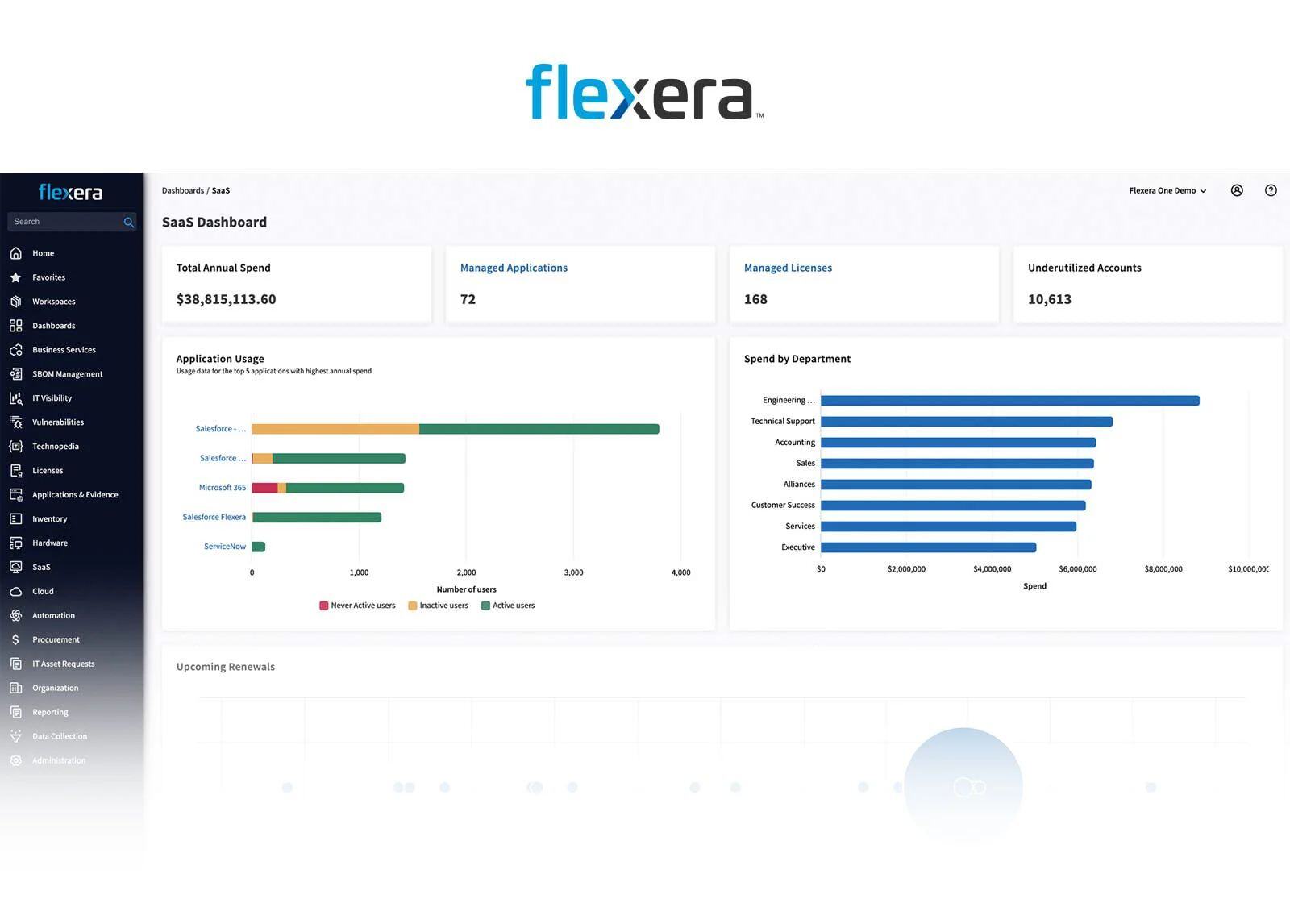 Flexera One is a unified, cloud-native IT Asset Management and FinOps platform built to manage hybrid IT environments at scale. It brings together ITAM, SaaS Management, Cloud Cost Optimization, and license governance under one roof — ideal for large enterprises with complex cloud usage and compliance demands.
Flexera One is a unified, cloud-native IT Asset Management and FinOps platform built to manage hybrid IT environments at scale. It brings together ITAM, SaaS Management, Cloud Cost Optimization, and license governance under one roof — ideal for large enterprises with complex cloud usage and compliance demands.
While Flexera once offered the standalone Cloud Management Platform (CMP) — based on its 2018 acquisition of RightScale — those infrastructure-focused capabilities have since been fully absorbed into Flexera One. As a result, Flexera One today includes everything CMP offered, plus much more.
Flexera One features
-
Cloud cost management & FinOps – Provides detailed visibility into IaaS, SaaS, and infrastructure spend across AWS, Azure, GCP; supports budgeting, rightsizing, and chargebacks .
-
SaaS Management – Detects cloud apps in use, optimizes subscriptions, and prevents waste.
-
Software license optimization – Reclaims unused licenses and ensures compliance with vendor agreements.
-
Hybrid IT visibility – Consolidates data from physical, virtual, and cloud environments into a single inventory.
-
Cloud governance & automation – Enforces policies, orchestrates provisioning, and includes self-service catalogs inherited from CMP.
-
Integrations – Seamlessly connects with ITSM (e.g., ServiceNow), procurement, endpoint management, and cloud provider APIs.
Flexera One pros
- Comprehensive platform blending ITAM, SaaS, FinOps, and cloud governance.
- Recognized leader in both software and Cloud Management.
- Advanced automation and policy enforcement tools.
- Strong analytics and reporting across hybrid environments.
- Scales well for enterprise-level workloads.
Flexera One cons
- High cost and complexity — better suited for organizations with significant cloud and licensing scale.
- Requires substantial configuration and onboarding.
- Some SaaS metrics and dashboards are still maturing, per user feedback.
Flexera One reviews and comments
Flexera One holds an average 4.5/5 rating across Gartner Peer Insights and G2. Users highlight its depth and ROI in cloud cost controls and license compliance.“The Self-Service User Interface is straight-forward in terms of a marketplace presence. The Cloud Management portal provides a convenient intermediate-level for platform-level and IT configuration and monitoring.”
G2 reviewer
There’s clear value in its unified approach, though some users caution about upfront investment and complexity.
Flexera One pricing
Flexera One uses a custom, quote-based model based on assets, modules, and cloud usage. No public pricing is available — you must contact Flexera for a tailored proposal.
